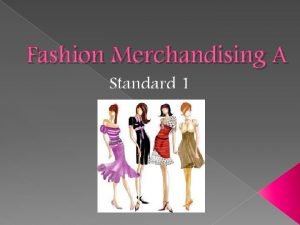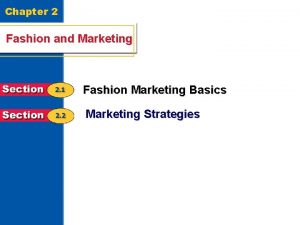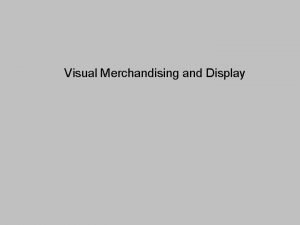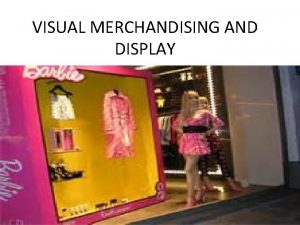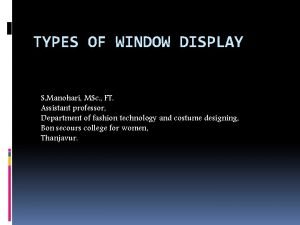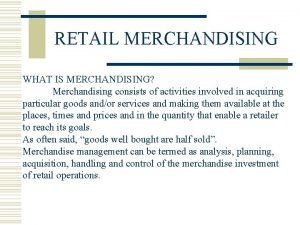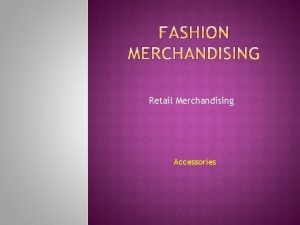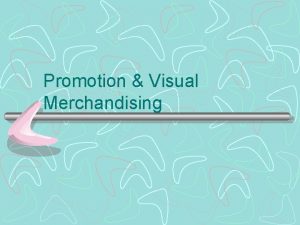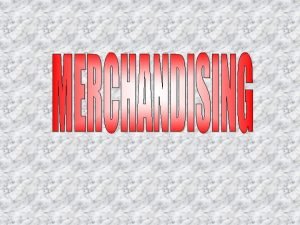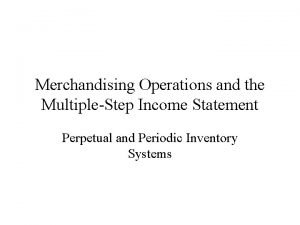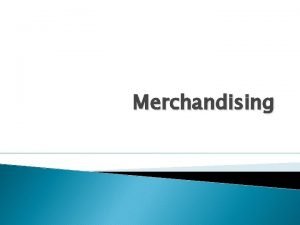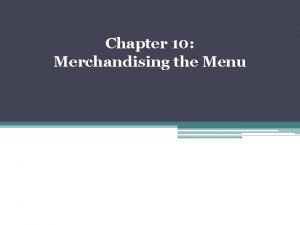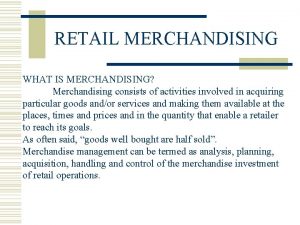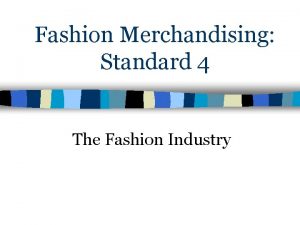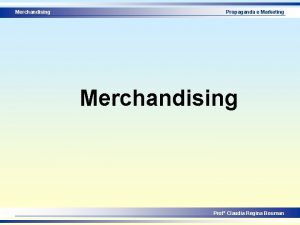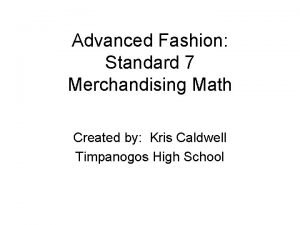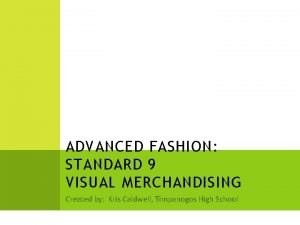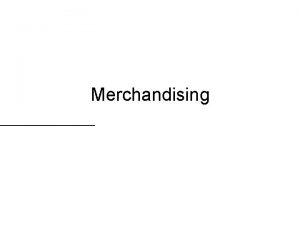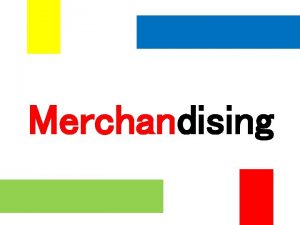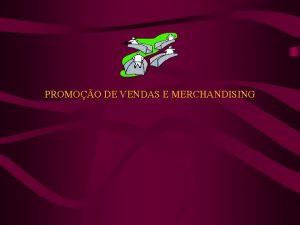Fashion Merchandising A Standard 2 Fashion Marketing Fashion





















- Slides: 21

Fashion Merchandising A Standard 2 Fashion Marketing

Fashion Merchandising A Standard 2 • Student will understand the basics of fashion marketing. • • Objective 1: Define Marketing Terms Objective 2: Describe the 4 P’s of Marketing Objective 3: Describe the methods of market segmentation Objective 4: Describe the six marketing functions

Marketing • The process of developing, promoting, and distributing products to satisfy customers’ needs and wants. It is a series of activities that fashion businesses undertake so that customers will buy products from them instead of their competitors.

Marketing Concept • To market effectively, fashion marketers follow the principles of the marketing concept, which is the idea that businesses must satisfy customers’ needs and wants in order to make a profit.

Target Market • The specific group of people that a business is trying to reach.

Market Segmentation • Identifying a group of consumers, or target market, is achieved through market segmentation, which is a way of analyzing a market by categorizing specific characteristics.

Methods of Market Segmentation • Demographics: personal • Geographics: statistics • Psychographics: based • Behavioral Segmentation : statistics about consumers based on characteristics such as age, gender, income, ethnic background, education, religion, occupation, & lifestyle. For Example: A retailer such as Pac. Sun targets a teen or young adult customer. on social & psychological characteristics such as attitudes, interests & opinions. For example: Pac. Sun, many of the customers may be interested in surfing or skateboarding. about where people live. Could include: region, city, county, & climate. For example: Pac. Sun tends to focus its marketing campaigns in warmer & coastal regions rather than in colder climates. their knowledge, attitudes, use, or response to a product. • Purchase Occasion: instance when a consumer might use a product – casual or work attire. • Product Benefits: study of the benefits that consumers desire in a fashion product or service such as stain or wrinkle-resistance. • Usage level & commitment : how often consumers use a product & their loyalty to purchasing it.

Fashion Merchandising • The planning, buying, and selling of fashion apparel and accessories to offer the right merchandise blend to meet consumer demand.

The Marketing Mix • To sell a fashion product to target customers, businesses must apply the marketing mix. The marketing mix consists of four basic marketing strategies (4 Ps) – product, price, place & promotion.

Product • Refers to what company is offering for sale to customers to satisfy their needs & wants. • Includes goods & services. • Fashion marketers develop strategies that include producing, packaging, & naming a product. • Examples of Goods: • Examples of Services:

Price • The amount of money consumers will pay for a product. • Fashion marketers must determine how much consumers are willing to pay.

Place • Refers to the way products are distributed and their systems of delivery. • Important place decisions include how & where a product will be distributed, where the customer will purchase the item, and when the product is distributed.

Promotion • Any form of communication that a business or organization uses to inform, persuade, or remind people to buy its product.

6 Functions of Marketing • Pricing • Channel Management • Promotion • Selling • Product/Service Management • Marketing-Information Management

Pricing Function • A primary goal of any business is to make a profit. A key factor in achieving this goal is to price a product accurately. Pricing includes how much to charge for goods & services in order to maximize profits. Although companies price their merchandise based on what the customer is willing to pay, they must be careful not to set prices so low that business does not make a profit.

Channel Management • This marketing function is responsible for identifying, selecting, monitoring, and evaluating sales channels, also known as channels of distribution. • Each channel of distribution is a path or route that goods and services take from the producer to the ultimate consumer or industrial user. These paths or routes aren’t physical, however. Instead, they refer to businesses or people who perform a variety of activities to enable products to be in the right places at the right times. • Effective channel management is often a key to a business’s success because it puts products in the customers’ hands.

Promotion Function • When new or existing products are developed, fashion marketers must promote their products to make sales. Promotion is the communication technique a business uses, such as advertising, and other promotional methods, to interest customers in buying the products. Manufacturers also promote their merchandise to retailers through catalog & Internet methods.

Selling Function • The selling function involves the direct personal contact that businesses have with their customers. Developing good selling skills is especially important for selling more expensive apparel and designer fashions. Sales personnel must be able to communicate the benefits & features of the items so that customers are willing to pay higher prices.

Product/Service Management • Fashion businesses must develop, maintain, & improve their products in response to customer demands. Fashion producers look for new ways to use existing items or produce new ones that will continue to interest the consumer. For example: a current textile in apparel is spandex. Although this material has been in existence for years, its popularity increased when designers began using it for women’s & men’s active-wear fashions.

Marketing-Information Management Function • The world of fashion is ever-changing. Gathering information is critical. Information is obtained primarily through marketing research, which helps fashion businesses determine their customers’ preferences & how to better market products. Businesses are able to effectively use the information through marketinginformation management systems. The five main elements are: • • Input – reports, past records, or surveys Storage – storing the information on a computer, jump drive, etc… Analysis – studying the information gathered Output – reports of the analysis & conclusions drawn from the information • Decision Making – the final results of the first four elements.

Channels of Distribution Indirect Direct Channel • The path of distribution in which products are sold by the producer directly to the customer. • The path of distribution of products that involves one ore more steps, or intermediaries. For example, a product moves from the manufacturer, to the wholesaler, to the retailer, and then to the consumer.
 Articles added to complete or enhance an outfit
Articles added to complete or enhance an outfit Std error
Std error Language
Language Standard cost accounting
Standard cost accounting Subjek dini sekolah menengah
Subjek dini sekolah menengah Dupont nylon shortage
Dupont nylon shortage Fashion marketing definition
Fashion marketing definition Fashion marketing mix
Fashion marketing mix Fashion marketing concept
Fashion marketing concept Fashion marketing concept
Fashion marketing concept Fashion marketing notes
Fashion marketing notes Ual definition
Ual definition Formal balance display
Formal balance display The physical outline of a display
The physical outline of a display Types of interior displays
Types of interior displays Which type of display window is angled back to the entry
Which type of display window is angled back to the entry Analiza swot vodafone
Analiza swot vodafone Factors affecting the merchandising function
Factors affecting the merchandising function Visual merchandising accessories
Visual merchandising accessories Promotion visual
Promotion visual Merchandising de ataque
Merchandising de ataque Income statement perpetual
Income statement perpetual
